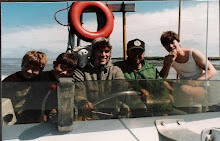







May 1-7, 2009 Transit the Panama Canal and Home
On May 2 we passed over the “bridge of water.” The Panama Canal transit was an all-day event, and we spent a lot of time on the deck. Margaret G. emailed that she watched our ship pass the Miraflores Locks! That was so exciting to us – what a grand world! Big freighters in the locks next to us had only two feet to spare on each side. There are strong “mules” that run along tracks next to the ships and attached by cables – two off the bow and two off the stern (or more “mules” on the huge ships). Their function is to keep the ships from scraping the canal or locks. (Picture with Captain Jeremy) They have cogs to drive them up the hills on the sides of the water escalator. There are big targets on grassy lawns at the locks: these are for line throwing practice. Ships go through the locks on a schedule, and they can pass going each way when they get to the big lake on the crossing. Fourteen thousand ships go through the Panama Canal annually. “The land divided, the world united” is the motto.
While passing through the Canal, we were followed by frigate birds. We glimpsed two crocodiles on the banks of the jungle. When we neared the Atlantic side, we saw pelicans. In the Caribbean, the flying fish are again sailing over the waves and crashing back into the water. We are going to miss watching the endless sea every day.
We went around Cuba in the Yucatan Channel where the Caribbean Sea and Gulf of Mexico meet. We traveled with the flow of the Yucatan Current.
Classes are over, and I was surprised to be honored by both of my professors as a “Distinguished Individual of Academic Excellence.” Wendy had her final dance performance: the students showcased dances from around the world (picture of one). At the end, Wendy did a moving hula “thank you” dance for everyone that brought tears to many eyes (picture). Matthew’s MICE group presented their final concert yesterday. The two of them added a lot of interest to the academic life of the ship.
More music has kept the trip lively – staff member Bob Balsley entertains along with students. They even had a “Battle of the Bands” one night. We attended an Ambassadors’ Ball, which was a dress-up dinner, and eight of our eleven Shipboard Family students came for a “family photo” (pictures). We’re packing and saying goodbye to so many new friends – our wonderful crew, the students, faculty and life-long learners. The final “Pre-port Lecture” was a spoof presented by students. The security rating for the USA was “high,” and we viewed how visitors might be prepared for the USA.
It is hard saying goodbye to everyone, so we are waving, “see you again.” Parents are swarming the Fort Lauderdale dock with signs welcoming their children home. We’ll be renting a car for our drive to Miami where we’ll stay for our morning flight on May 7.
Processing all we’ve seen, heard, smelled, tasted and all the things that have touched our hearts will take some time. What we do with our new knowledge is yet to be discovered. For now, we will enjoy again our family and friends, our home.















































